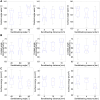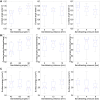Effect of Different Sandblasting Parameters on the Properties of Additively Manufactured and Machined Titanium Surfaces
- PMID: 40294985
- PMCID: PMC12042000
- DOI: 10.21873/invivo.13979
Effect of Different Sandblasting Parameters on the Properties of Additively Manufactured and Machined Titanium Surfaces
Abstract
Background/aim: In dentistry, the surfaces of titanium implants are often sandblasted and acid-etched in order to support successful osseointegration. The aim of this study was to investigate the impact of various sandblasting parameters on the surface roughness, contact angle and surface energy of additively manufactured (TiAl6V4) and machined commercially pure titanium (cpTi) surfaces.
Materials and methods: A total of 56 disc-shaped samples were produced using either laser powder bed fusion (TiAl6V4) or using precision cutting (cpTi). The samples were then sandblasted with different angles, distances, and pressures using an automated sandblasting machine. Afterwards, surface roughness and contact angle for water and diiodomethane were measured, and scanning electron microscopy images were taken.
Results: The results showed that the initially rough TiAl6V4 samples became smoother after sandblasting, while the smooth cpTi surfaces became rougher. Sandblasting pressure had the most significant influence on surface roughness. The surface energy of sandblasted TiAl6V4 samples showed no significant change compared to the as-built state (26.6±1.3 to 26.3±1.8 mJ/m2). In contrast, cpTi samples showed a reduction in surface energy after sandblasting (32.3±1.6 to 26.8±1.2 mJ/m2). Scanning electron microscopy revealed irregular surfaces with grooves and ridges for both types of samples. The roughness of TiAl6V4 decreased at higher sandblasting pressures, whereas cpTi surfaces became rougher.
Conclusion: Surface roughness after sandblasting is strongly influenced by the initial surface, which differs in additively manufactured TiAl6V4 samples compared to machined cpTi surfaces.
Keywords: Additive manufacturing; LPBF; TiAl6V4; commercially pure titanium; contact angle; laser powder bed fusion; osseointegration; sandblasting; sandblasting parameters; surface energy; surface roughness; titanium implants.
Copyright © 2025, International Institute of Anticancer Research (Dr. George J. Delinasios), All rights reserved.
Conflict of interest statement
The Authors declare no conflicts of interest. The funders had no role in the design of the study; in the collection, analyses, or interpretation of data; in the writing of the manuscript; or in the decision to publish the results.
Figures













References
-
- Wong KV, Hernandez A. A review of additive manufacturing. Int Sch Res Notices. 2012;2012:1–10. doi: 10.5402/2012/208760. - DOI
-
- Jiménez M, Romero L, Domínguez IA, Espinosa MDM, Domínguez M. Additive manufacturing technologies: an overview about 3D printing methods and future prospects. Complexity. 2019;2019(1):1–30. doi: 10.1155/2019/9656938. - DOI
-
- Ngo TD, Kashani A, Imbalzano G, Nguyen KT, Hui D. Additive manufacturing (3D printing): A review of materials, methods, applications and challenges. Composites Part B-Engineering. 2018;143:172–196. doi: 10.1016/j.compositesb.2018.02.012. - DOI
-
- Moiduddin K, Darwish S, Al-Ahmari A, Elwatidy S, Mohammad A, Ameen W. Structural and mechanical characterization of custom design cranial implant created using additive manufacturing. Electron J Biotechnol. 2017;29:22–31. doi: 10.1016/j.ejbt.2017.06.005. - DOI
MeSH terms
Substances
LinkOut - more resources
Full Text Sources
